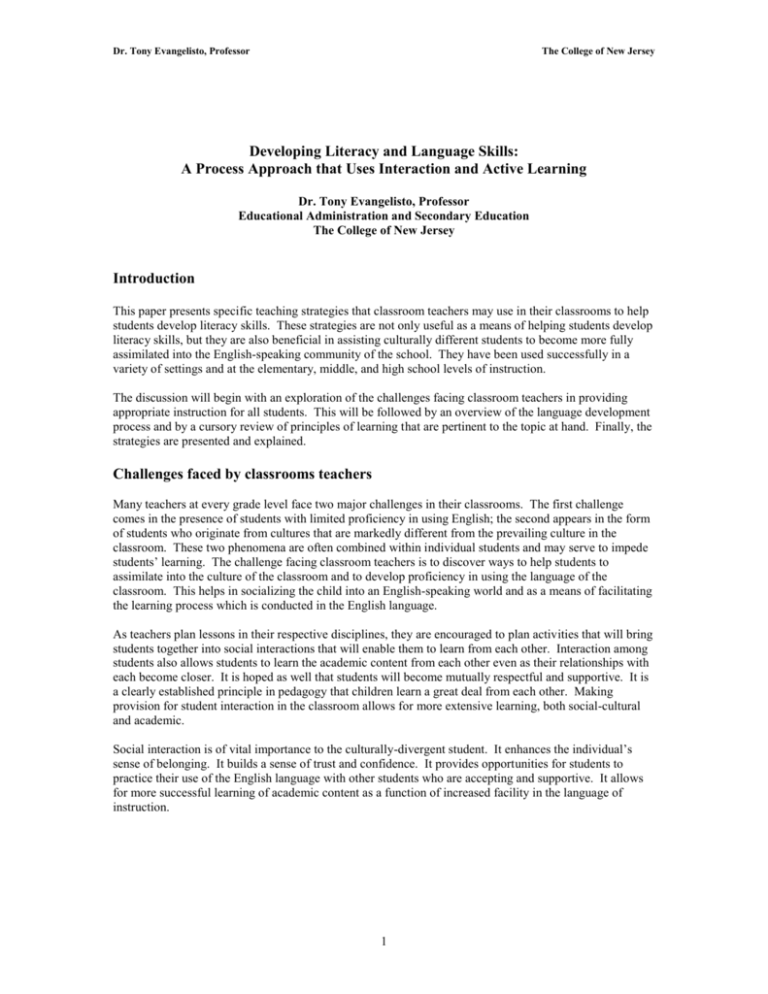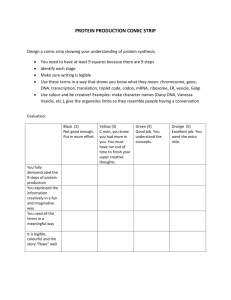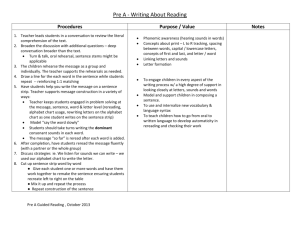Some fundamental notions regarding the development of language
advertisement

Dr. Tony Evangelisto, Professor The College of New Jersey Developing Literacy and Language Skills: A Process Approach that Uses Interaction and Active Learning Dr. Tony Evangelisto, Professor Educational Administration and Secondary Education The College of New Jersey Introduction This paper presents specific teaching strategies that classroom teachers may use in their classrooms to help students develop literacy skills. These strategies are not only useful as a means of helping students develop literacy skills, but they are also beneficial in assisting culturally different students to become more fully assimilated into the English-speaking community of the school. They have been used successfully in a variety of settings and at the elementary, middle, and high school levels of instruction. The discussion will begin with an exploration of the challenges facing classroom teachers in providing appropriate instruction for all students. This will be followed by an overview of the language development process and by a cursory review of principles of learning that are pertinent to the topic at hand. Finally, the strategies are presented and explained. Challenges faced by classrooms teachers Many teachers at every grade level face two major challenges in their classrooms. The first challenge comes in the presence of students with limited proficiency in using English; the second appears in the form of students who originate from cultures that are markedly different from the prevailing culture in the classroom. These two phenomena are often combined within individual students and may serve to impede students’ learning. The challenge facing classroom teachers is to discover ways to help students to assimilate into the culture of the classroom and to develop proficiency in using the language of the classroom. This helps in socializing the child into an English-speaking world and as a means of facilitating the learning process which is conducted in the English language. As teachers plan lessons in their respective disciplines, they are encouraged to plan activities that will bring students together into social interactions that will enable them to learn from each other. Interaction among students also allows students to learn the academic content from each other even as their relationships with each become closer. It is hoped as well that students will become mutually respectful and supportive. It is a clearly established principle in pedagogy that children learn a great deal from each other. Making provision for student interaction in the classroom allows for more extensive learning, both social-cultural and academic. Social interaction is of vital importance to the culturally-divergent student. It enhances the individual’s sense of belonging. It builds a sense of trust and confidence. It provides opportunities for students to practice their use of the English language with other students who are accepting and supportive. It allows for more successful learning of academic content as a function of increased facility in the language of instruction. 1 Dr. Tony Evangelisto, Professor The College of New Jersey Some fundamental notions regarding the development of language and literacy skills The teaching strategies presented below are predicated upon the author’s beliefs regarding the development of language in individuals. Developmentally appropriate instruction proceeds from an understanding of human development; for purposes of the present discussion, language development is the critical focus. Language development proceeds in an orderly progression over a period of time. It begins at birth as the child inherits the physical and intellectual capacities that are required for the production of speech. Initially, the child produces random sounds and takes in a great deal of auditory sensory data while listening to family members and others using language. Over a long period of time, the child produces a narrower range of sounds, essentially mimicking and repeating the sounds that are being heard at home. A critical aspect of this process is that language learning involves a great deal of social interaction between and among individuals in the child’s environment. Eventually, certain sounds take on special meaning; this is the early vocabulary development that progresses dramatically in time. The sounds that the child ascribes meaning to are sounds that label familiar objects, persons, or experiences in the child’s world. In effect, concrete objects and direct experiences are connected with the words that the child learns initially, and the oral/aural learning that occurs is powerful and indelible. In the process, the child internalizes the grammar of the native language, inferring and replicating the syntactic structures at work within the native language and uses that knowledge to produce new utterances to convey the child’s experiences, utterances that are not being memorized and repeated. Once again, it is significant to note that social interaction is a vital component of the language learning process. As the process of learning to read begins, the child must learn the graphemic representations for the sounds that have been learned earlier. That is, the child must recognize the letters of the alphabet and be able to produce the sounds that they symbolize, and ultimately understand the words that they spell out. This is a critical juncture, for the language process becomes more abstract than ever before. In the earlier stage of the process, the child learns sounds (words) that stand for concrete objects or experiences. Now, the child must learn to recognize the printed symbols that represent the sounds which signify the concrete objects or experiences. The degree of abstraction has increased; so has the level of complexity and difficulty. At this point in the child’s schooling, reading books and textbooks may rely less and less on visual and concrete representations that aid in understanding (i.e., pictures or illustrations). The words themselves become more of a central focus, and children are required to function at a more abstract level of languaging with fewer aids to assist them. For the child who is learning to read and write in the native language (L1), this process is challenging enough. For the child who attempts to learn reading and writing in a second language (L2), the challenge increases exponentially. I.e., ESL or bilingual students do not have the many years of language development in English (from birth to the start of schooling) to provide them the basis for reading and writing in English. Rushing them through a language program cannot replace the lack of the initial language development experiences in English that their English-as-a-first-language classmates possess. The basic realization that emerges from these realities is that students who have not developed a strong language base before facing the prospect of learning how to read and write, must be provided opportunities to develop that language base in a manner that replicates the process of learning language in the early childhood years: it must be built upon lots of experience and practice (a constant process of languaging in all of its forms) and it must be as concrete as possible so that the connections between words (as they sound and as they look in print) and the real world are as overt and as obvious as possible. Multiple experiences, extensive practice, and concrete learning activities are essential. 2 Dr. Tony Evangelisto, Professor The College of New Jersey Some teaching implications that derive from concepts related to language development 1. 2. Teaching processes which replicate language development processes are more likely to succeed than those which do not. Teachers are advised to: a. Provide abundant repetitions in using language – i.e., if we learn language originally through the constant exposure to and use of the elements of the language, then common logic dictates that this same mechanism works in learning a second language. b. Begin with concrete experiences related to words – if words are abstract symbols for sounds, which in turn are symbols for real objects or phenomena in the real world, then the degree of abstraction inherent in words is likely to present a challenge to learners. Connecting words to concrete referents is a means for making the learning more accessible to students. Concrete learning serves as a foundation for abstract learning. c. Rely upon social interaction as a means of developing language facility – human beings learn from many sources, and one of the most powerful sources of learning is other people. Social learning is an effective and powerful medium of instruction. Teachers are certainly well aware of the effects of peer interaction and peer learning. The success of Cooperative Learning and other varieties of group activity gives credence to this notion. d. Encourage students to construct meanings as a vehicle for practicing the use of language skills within a context that is familiar, concrete, and flexible. In this way, students are employing a constructivist approach that requires thinking, using their creative abilities, problem-solving, exchanging ideas with others in social interactions, and then framing their ideas in words and sentences. Teachers may help their culturally different students by: a. Recognizing that the L2 student (the student for whom English is not the first language nor the dominant language) does not have the language base that L1 students have and require the repetitions, concreteness, and social interaction even more than their L1 counterparts do. b. Remembering that culturally different students/L2 students are also faced with a sense of isolation and frustration that often occur in individuals who are not native or not born into the dominant culture. For this reason, teachers are encouraged to help these students by providing more opportunities for interaction with classmates as a means of fostering socialization and language skills. Teaching reading/writing skills with Comic Strips 1. Provide students with scrambled comics to arrange into order and write a sentence to express the main idea of the combined frames. Students read the visual cues along with the verbal cues as presented in the "dialogue balloons" [the part of the comic which expresses the words of the characters] and must construct meaning from them. The visual, concrete illustrations provide information that assists the reader in understanding the verbal content]. The teacher may ask the students to write a single sentence to convey the main idea of the comic strip. 3 Dr. Tony Evangelisto, Professor The College of New Jersey 2. Provide students with scrambled comics to arrange into order and write a paragraph based on it – one sentence per frame. This activity represents a higher level of challenge than the activity presented in the preceding one. 3. Provide students with comics with empty dialogue balloons to write dialogue for each balloon. The visual clues help the students to determine the meaning (albeit, at a highly idiosyncratic level) of the comic strip; adding the verbal content allows students to construct meaning and give language to it in a concrete situation. 4. Have students read comics and then write captions for the idea(s) contained in them. Again, students are asked to construct meanings related to the visual clues that are provided. 5. Cut out pictures of four comic strip characters with an arrow to spin for writing dialogue – students in groups take turns at spinning the spinner (arrow mounted so that it can spin) and writing dialogue for the character that the arrow indicates when it stops. 6. Create a comic strip to tell a story. This activity provides students with an opportunity to develop their own story, draw their own cartoons, and supply the content for the "dialogue balloons" in which the characters speak. Students may be encouraged to create these on the basis of individual or shared experiences. 7. Use a partial comic strip, with the last frame omitted, and have students create the frame based upon the preceding frames. This allows students to practice the skills of reading for main idea and detail as well as for predicting outcomes. 8. Provide students with a complete comic strip and ask them to create and perform a rap song for it, capturing and conveying the main ideas contained in it. Teaching reading/writing skills with trading cards 1. Provide students with a pack of baseball (or other sport) trading cards; have them arrange the cards alphabetically by the name of the player. Students are then asked to transcribe the names onto a sheet of paper to be submitted for checking by the teacher. The extra step of writing the names down in alphabetical is a means of adding a kinesthetic element to the process of learning the alphabet. 2. Using the statistical data and other information provided on a pack of trading cards, write a brief biography of one player (of the student’s choice). 3. Provide students with a simple short story and have them create trading cards for the characters in the story (draw a picture of the character on the front, then a brief statement about the character on the reverse side of the card, based on information provided in the story). 4. Interdisciplinary activity: Provide students with a map of the United States and have the students organize and alphabetize the players by region of the country or by State. 5. Interdisciplinary activity: Provide students with a map of California and 15 to 20 trading cards of players from that state and have the students write a listing of the players in terms of birth place from north to south. 6. Interdisciplinary activity: As students read about historical figures in social studies class, math or science class, or elsewhere, have the students prepare trading cards for them (with drawings of the historical figures on the front and biographical data and sketches on the reverse side) 4 Dr. Tony Evangelisto, Professor The College of New Jersey Using various visual materials or concrete objects for teaching reading and writing skills 1. Have students read a short story/poem/short novel/play and have them create posters (similar to posters that are used to advertise motion pictures in movie houses). 2. Have students create book jackets for a short story/poem/short novel/play and have them draw illustrations for the front and analytical or evaluative comments about the contents, much as critics’ comments appear on the backs of book jackets. Biographical sketches of the authors, or plot summaries may also be provided on the book jackets. 3. Have students illustrate scenes from a story, novel, or play, then provide a caption for their illustrations (the captions are to be excerpts taken verbatim from the source that are appropriate for the drawings that have been done). 4. Interdisciplinary activity: As students read about historical events, have them create movie posters for those events, providing highlighted information regarding them. 5. Interdisciplinary activity: For historical events that students have read about, have them write and perform rap songs about those events. 6. Interdisciplinary activity: As students read about various cultures of the world, or countries, have them develop travel brochures not only contain visual representations of the cultures or the countries but also factual data or descriptive data related to them. 7. Provide students with several small beany babies, plastic animals or figures, or similar objects and have them write dialogue for them to tell a story. Assessing Student Products/Performances Each activity is intended to yield a product or a written record that can be assessed to ascertain a student’s level of proficiency. Teachers are reminded that the measures of performance with reference to literary skills need to be reasonable and flexible. In many instances, multiple possibilities of interpretation exist, so students’ responses should be evaluated on the basis of the logic supplied by the student rather than against an absolute rigid standard. The rubric should allow answers to be counted as correct if they can be substantiated by a logical defense by the student. For instance, in arranging comic strip frames into their “proper” order, the student may interpret the contents differently from the originator’s intention and can be given credit if it can be defended successfully. The process is the primary emphasis of the activity; the product merely provides evidence that the process has been accomplished effectively. As students complete activities, and as results are assessed, teachers may track students’ progress over time by keeping a record of assessments on each skill. The difficulty levels may then incrementally increase as students show mastery at lower skill levels. Summary remarks There are many theories and beliefs regarding how individuals learn and how teachers might teach accordingly. The suggestions presented here are intended to provide classroom teachers with some ideas or approaches that may be helpful in facilitating literacy skills in students. These ideas are also proposed to be used within the context of student interaction in pairs and in small groups so as to foster interaction among culturally different students. The interaction, it is hoped, will facilitate social learning that has a beneficial effect on developing literacy skills along with greater cultural awareness and acceptance among the students themselves. Fundamentally, the activities are intended to put into practice the basic tenets of 5 Dr. Tony Evangelisto, Professor The College of New Jersey behaviorist and classical conditioning types of learning theories which contend that drill-and-practice and constant repetitions are the means whereby we learn, and also to implement the basic notions of gestalt and similar learning theories which suggest that insight learning, problem-solving, and constructing meanings (constructivism) foster higher-order thinking skills. It is the author's hope that teachers will find these ideas helpful and that their students will learn the vital skills that they need for success in a complex and challenging world. The strategies presented above have been used successfully. Students develop literacy skills and learn to respect each other by participating together in a process that is highly motivational, challenging, and concrete in its focus. 6








